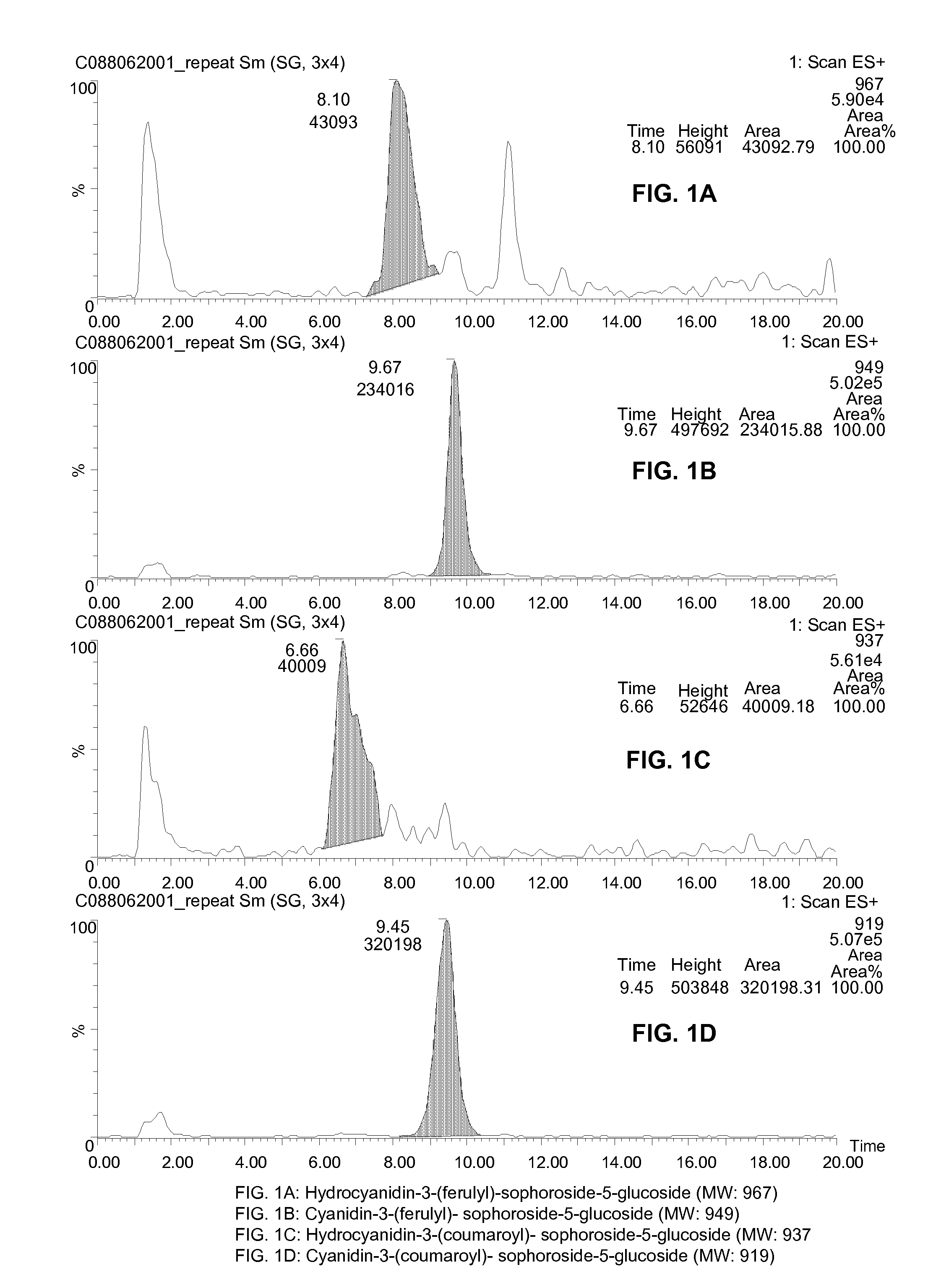Methods for Creating Color Variation in Anthocyanins Produced by Cell Culture
a cell culture and anthocyanin technology, applied in the field of plant cell culture, can solve the problems of large volume of extract preparation, low stability of anthocyanins as food colorants, and limited harvesting
- Summary
- Abstract
- Description
- Claims
- Application Information
AI Technical Summary
Benefits of technology
Problems solved by technology
Method used
Image
Examples
example 1
Ammonium Molybdate Treatment of Callus
[0081]This example illustrates the ability of ammonium molybdate to change the color of anthocyanins from red to blue using red cabbage callus as an exemplary system.
[0082]Thirty seeds of Red cabbage “Ruby ball” (Brassica oleracea) were put into 50 mL tube and 3040 mL of 25% bleach containing 1 drop of Tween-20 per 100 mL of bleach solution was added to the tube. The tube was agitated on the Labquake shaker for 15 minutes. Seeds and bleach were poured through sterile tea strainer. The seeds were then rinsed three times with sterile water and plated on germination medium based on MS salts including MS vitamins (B0254 in Table 1), 30 g / L sucrose and 2.0 g / L Phytagel. The pH of the medium was adjusted to 5.8 before autoclaving for 15-20 minutes at 121° C., 1.25 kg / cm2. Seeds were maintained at 23° C. with a sixteen hour white fluorescent light (60 μM) period and an eight hour dark photoperiod for three weeks. After three weeks, germinated seedlings...
example 2
Ammonium Molybdate Treatment of Purple Carrot Suspension Cells
[0087]This example illustrates the ability of ammonium molybdate to change the color of anthocyanins from red to blue in suspension cultures of purple carrot cells.
[0088]Carrot (Daucus carota) suspended cells of cell line PC11H38 were grown in 125 mL Erlenmeyer flasks including using DC1151 Medium on a gyratory shaker at 100 RPM in white fluorescence light (16 hours light / 8 hours dark) at 23° C. After 7 days, 10 mL of spent medium was removed and fresh medium was added into the cultures to bring the volume up to 40 mL working volume. At day 14, the same subculture was repeated. At day 21, the cultures were transferred to 250 mL Erlenmeyer flasks and fresh medium was added to bring the volume up to 80 mL. At day 28, the cultures were moved to UV-B light condition (16 hours UV-B / 8 hours dark) at 23° C. after decanting some medium and adding the same volume of fresh medium. Exposure of cultures to UV-B light induced the prod...
example 3
Characterization of Anthocyanins Present in Callus and Suspension Cells
[0096]This example illustrates the types of anthocyanins present in plant tissue cultures, using red cabbage callus or carrot suspended cells as an exemplary system.
[0097]Anthocyanins were extracted from approximately 0.25±0.04 g fresh weight of cabbage calli or carrot suspended cells with 1.5 mL 50% (v / v) aqueous ethanol including 0.1% H2SO4 or with 1.5 mL 99.9% (v / v) methanol including 0.1% H2SO4. The cells were collected in a microcentrifuge tube (2.0 mL) and homogenized with a bead mill homogenizer for 1 minute. The homogenates were centrifuged in a clinical centrifuge at 4000 RPM for 4 minutes and only the supernatants were moved in another microcentrifuge tube.
[0098]This extract was tested for its absorbance at 520 nm and anthocyanin content was calculated using Beer's law (A520×1000×MW of cyanidin glucoside) / (extinction coefficient).
[0099]The amounts and types of anthocyanins found in the extracts were det...
PUM
 Login to View More
Login to View More Abstract
Description
Claims
Application Information
 Login to View More
Login to View More - R&D
- Intellectual Property
- Life Sciences
- Materials
- Tech Scout
- Unparalleled Data Quality
- Higher Quality Content
- 60% Fewer Hallucinations
Browse by: Latest US Patents, China's latest patents, Technical Efficacy Thesaurus, Application Domain, Technology Topic, Popular Technical Reports.
© 2025 PatSnap. All rights reserved.Legal|Privacy policy|Modern Slavery Act Transparency Statement|Sitemap|About US| Contact US: help@patsnap.com



